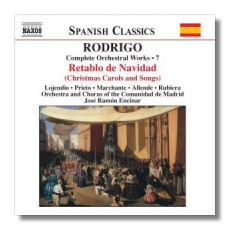
The Internet's Premier Classical Music Source
Related Links
- Rodrigo Reviews
- Latest Reviews
- More Reviews
-
By Composer
-
Collections
DVD & Blu-ray
Books
Concert Reviews
Articles/Interviews
Software
Audio
Search Amazon
Recommended Links
Site News
 CD Review
CD Review
Joaquín Rodrigo

Complete Orchestral Works, Volume 7
– Christmas Carols & Songs –
- Retablo de Navidad
- Himnos de los neófitos de Qumrán
- Música para un códice salmantino
- Cántico de San Francisco de Asis
Raquel Lojendio, María Jesús Prieto, Victoria Marchante, Ada Allende, sopranos
David Rubiera, baritone
Orchestra & Chorus of the Comunidad de Madrid/José Ramón Encinar
Naxos 8.557223 DDD 71:48
Naxos' valuable series of Joaquín Rodrigo's complete orchestral works progresses to Volume 7 with this varied collection of works for chorus and orchestra. The release is timely, as the longest work is Retablo de Navidad (1952), a group of eight songs for Christmas. As I was hearing this music, I assumed that the composer was setting traditional melodies, but the booklet notes seem to say that these melodies really are Rodrigo's own, albeit in a folkloric style. Soprano Raquel Lojendio is the lovely soloist in five of the songs; together, she and the baritone also sing a lullaby for the baby Jesus. This charming music is completely free from affectation, and I recommend letting it blow its warm breezes over your holiday celebrations this year.
Music for a Salamancan Codex was composed one year later. Here, the text is by famous Spanish author Miguel de Unamuno, who had been associated with the ancient University of Salamanca. The chorus and the baritone share Unamuno's words, which are a paean to the University and to the city itself. Rodrigo's heartfelt, low-key music hearkens back to the Renaissance era without turning to pastiche.
Rodrigo mines a more mysterious vein in the three Hymns of the Neophytes of Qumran; the first hymn was written in 1965, and the composer added two more in 1974. The texts are a poetic adaptation of the Dead Sea Scrolls. This music was intended to complement Holy Week celebrations in Cuenca. Three sopranos blend their voices together in eerie beauty, and the male chorus provides a firm underpinning, often through chanting. This is one of those few works in which Rodrigo chose to set aside conventional tonality; the results are not difficult for the average listener to enjoy, however. In terms of tuning, the three sopranos have their work cut out for them – this is one of those works that is more difficult than it sounds. This is Rodrigo at his most Arvo Pärt-ish, if you will.
Written in 1982, the Canticle of Saint Francis of Assisi was one of Rodrigo's last works. Again, Rodrigo sets the Saint's words of praise with simple devotion; no bombast mars the music or the Saint's message. Does the opening flute solo evoke the birds he loved so well? Religious mysticism is at the forefront here, as it is in the three Hymns, but the Canticles are more straightforwardly melodic.
The Madrid-based chorus and orchestra were formed in the 1980s, but already they have achieved international recognition. Rodrigo's choral writing is difficult because it is so exposed, but this ensemble handles the challenges well. Encinar, the orchestra's Principal Conductor since 2000, leads the music with the tenderness it deserves. Blessedly, Naxos' booklet includes Spanish texts and English translations, and the engineering is excellent. Here's another "don't miss" release, then, particularly if you associate the composer with the Concierto de Aranjuez and nothing but.
Copyright © 2003, Raymond Tuttle


















